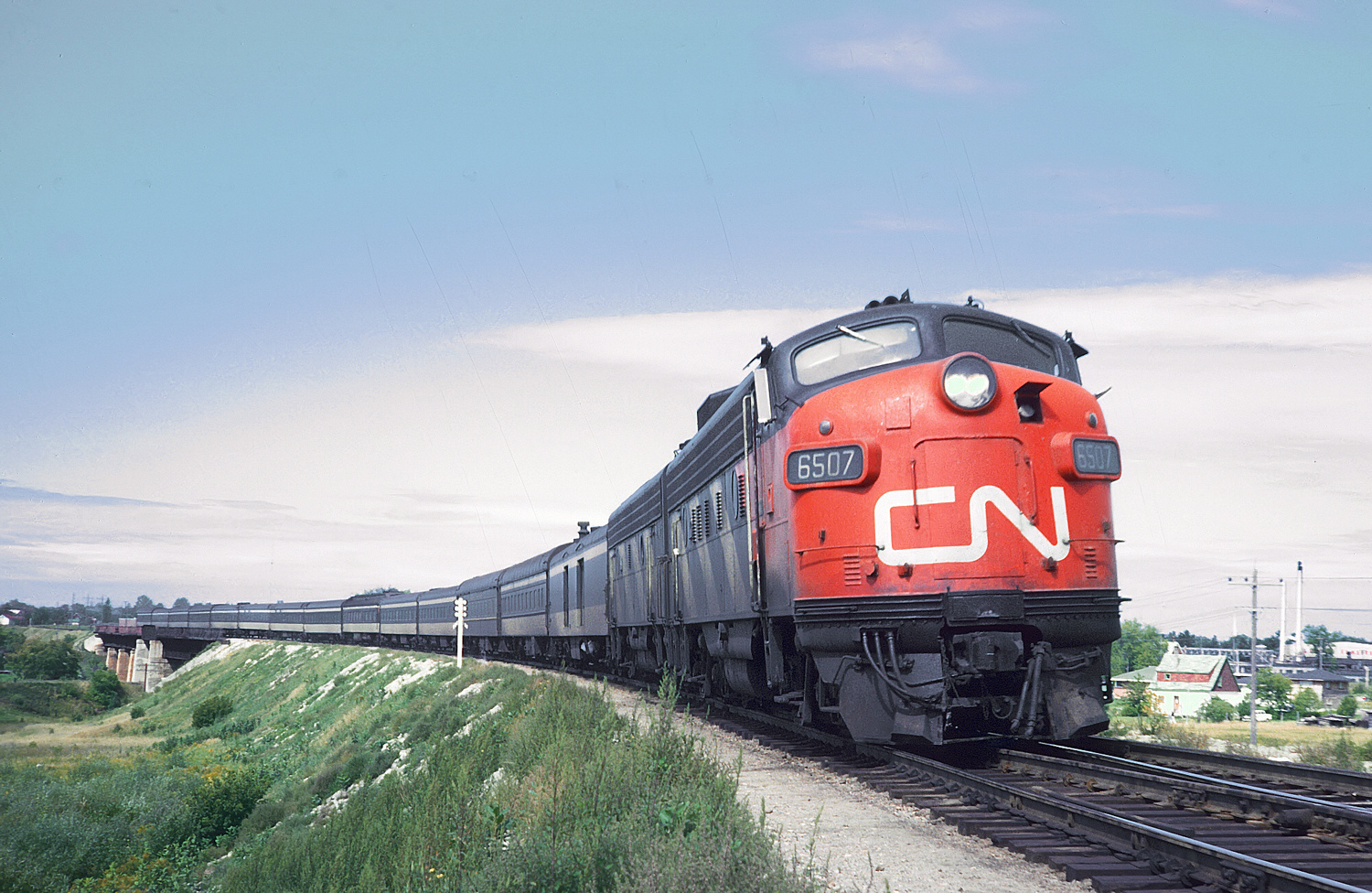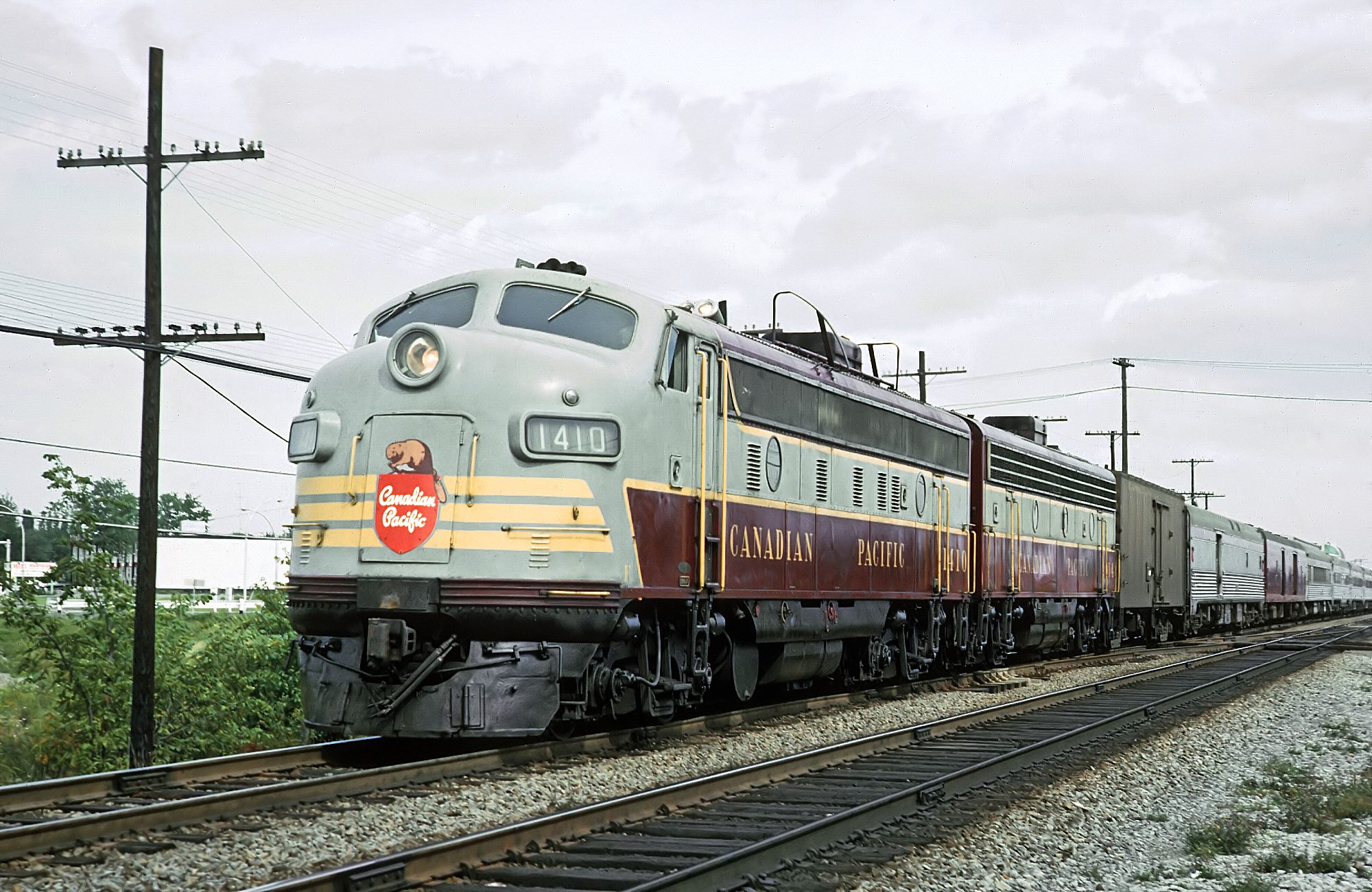EMD/GMD "FP9" Locomotives: Specs, Roster, History
Last revised: November 5, 2024
By: Adam Burns
The FP9 was the passenger variant of Electro-Motive's final traditional F series model, the F9. With interest waning for streamlined diesels by the mid-1950s, and rail travel in decline, no U.S. railroad elected to purchase the FP9 (although Chicago & North Western did have former FTA's #5400A, 5400D - 5401A, 5401D rebuilt into FP9s in 1955).
However, both major Canadian lines, Canadian Pacific and Canadian National, purchased the model, as did Ferrocarril Nacional de México (Mexico) and the Saudi Arabian government.
As Brian Solomon notes in his book, "Electro-Motive: E Units and F Units," as part of the F9 line, the FP9 was the most reliable, rugged, and powerful, in the F series.
Interestingly, after wrapping up their careers in Canada a number of units found their way to the United States leading business trains at places like Kansas City Southern, Pan Am Railways, and Ohio Central. Despite fewer than 100 examples produced during a five year production run, a number of FP9s remain preserved throughout North America.
Photos
 This fabulous photo was taken by Roger Puta depicting Canadian National's "Super Continental" led by FP9 #6507, arriving in Pembroke, Ontario on September 6, 1965.
This fabulous photo was taken by Roger Puta depicting Canadian National's "Super Continental" led by FP9 #6507, arriving in Pembroke, Ontario on September 6, 1965.Overview
The F9 marked the pinnacle of Electro-Motive's traditional F series. Unfortunately, by the time it was introduced in 1953 interest in streamlined freight locomotives had largely passed.
While the F7 proved incredibly successful with nearly 4,000 examples sold -making it EMD's best-selling model up until that time - railroads soon discovered there was little monetary gain from operating freight trains with streamlined locomotives.
The GP7, of late 1949, was designed for general freight service, and proved a much more efficient platform in this regard. It offered crews excellent visibility and could be utilized in all types of applications; road service, branch line duties, or even switching assignment. It sold more than 2,700 examples by 1954. The following GP9 saw even higher sales.
The F9 was part of EMD's so-called "9 Line" which included the F9, GP9, and E9 all of which entered the builder's catalog in 1953/1954.
The F9's most notable improvement was its use of EMD's latest 567 power plant, the 567C. This engine, as Mr. Solomon notes, was the most advanced in the series.
Its upgrades included a redesign of the engine crankcase to withstand a greater beating in daily service, replacement of water seals susceptible to leaking on older model 567s, and an improved cooling circuit.
As a specialized design the FP9 was principally intended for passenger service. When EMD first introduced its four-axle F series in 1939, the models included an optional steam generator.
A number of railroads soon discovered their B-B trucks performed much better in mountainous territory than EMD's "E" series passenger models. The Santa Fe, for example, equipped most of its transcontinental runs, like the Super Chief and El Capitan, with F3s and F7s.
As a result, EMD cataloged the FP7, a variant of the F7, featuring a stretched frame that could sufficiently house a steam generator and the necessary water supply. The model enjoyed modest sales of more than 400 units; such demand warranted EMD to continue the series with the FP9.
Data Sheet and Specifications
| Entered Production | 2/1954 (Canadian Pacific #1405) |
| Years Produced | 2/1954 - 12/1959 |
| Engine | 567C |
| Engine Builder | GM |
| Horsepower | 1750 |
| RPM | 835 |
| Cylinders | 16 |
| Length | 54' 8" |
| Height (Top Of Rail To Top Of Cab) | 15' 0" |
| Width | 10' 8" |
| Weight | 230,000 Lbs |
| Fuel Capacity | 1,200 Gallons |
| Air Compressor | Gardner-Denver |
| Air Compressor Model | WBO |
| Air Brake Manufacturer | Westinghouse |
| Air Brake Schedule | 24RL |
| Trucks | B-B |
| Truck Type | Blomberg |
| Truck Wheelbase | 9' |
| Wheel Size | 40" |
| Traction Motors | D37 (4), GM |
| Primary Generator | D12D, GM |
| Auxiliary Generator | Delco (A8102) |
| Alternator | D14 |
| MU (Multiple-Unit) | Yes |
| Dynamic Brakes | Yes (A Units) |
| Tractive Effort (Starting) | 56,500 Lbs at 25% |
| Tractive Effort (Continuous/Average) | 40,000 Lbs at 9.3 mph |
| Gear Ratios | 62:15, 61:16, 60:17, 59:18, 58:19, 57:20, 56:21 |
| Top Speeds | 65 mph, 71 mph, 77 mph, 83 mph, 95 mph, 102 mph |
Production Roster
Total Built = 90
Electro-Motive
| Owner | Road Number(s) | Serial Number(s) | Order Number | Completion Date | Heritage |
|---|---|---|---|---|---|
| Chicago & North Western | 4051A-4054A | 3115-3118 | 7521 | 7/1955, 10/1955-11/1955 | FTA's #5400A,5400D-5401A,5401D |
General Motors Diesel
| Owner | Road Number(s) | Serial Number(s) | Order Number | Completion Date |
|---|---|---|---|---|
| Canadian Pacific | 1405-1415 | A589-A599 | C175 | 2/1954-5/1954 |
| Canadian National | 6500-6512 | A630-A642 | C183 | 9/1954-1/1955 |
| Canadian National | 6513 | A764 | C183 | 2/1955 |
| Canadian National | 6514-6522 | A1044-A1052 | C217 | 1/1957-3/1957 |
| Canadian National | 6523-6532 | A1195-A1204 | C230 | 3/1957-5/1957 |
| Canadian National | 6533-6542 | A1393-A1402 | C242 | 5/1958-7/1958 |
Export
| Owner | Road Numbers | Serial Numbers | Order Numbers | Completion Date |
|---|---|---|---|---|
| Ferrocarril Nacional de México | 7010-7019 | 22530-22539 | 701327-701336 | 8/1956-10/1956 |
| Ferrocarril Nacional de México | 7020-7034 | 22651-22665 | 701129-701143 | 10/1956-11/1956 |
| Saudi Government Railway | 1502 | 22707 | 701553 | 11/1956 |
| Saudi Government Railway | 1503-1504 | 23299-23300 | 701493-701494 | 4/1957 |
| Saudi Government Railway | 1505-1508 | 26037-26040 | 702272-702275 | 12/1959 |
 Canadian Pacific FP9 #1410 with train #1, the westbound "Canadian" (Montreal, Quebec - Vancouver, British Columbia), stopped at Dorval, Quebec on September 6, 1965. Roger Puta photo.
Canadian Pacific FP9 #1410 with train #1, the westbound "Canadian" (Montreal, Quebec - Vancouver, British Columbia), stopped at Dorval, Quebec on September 6, 1965. Roger Puta photo.The model was otherwise identical to an F9. It was equipped with EMD's latest prime mover (567C), traction motor (D37), and other internal improvements.
These upgrades made the F9 line the most reliable, powerful, and rugged in the series. There was no cabless booster offered in the FP9 (the FP7 was likewise cataloged without boosters).
Unfortunately, most U.S. railroads had moved on from streamlined diesels by the mid-1950s and no American lines purchased new FP9s.
However, as previously mentioned, the C&NW had four former FTs rebuilt into FP9s and the model did find interest in Canada, Mexico, and Saudi Arabia. Ultimately, only 90 units were sold.
Spotting Features
In the FP7, the easiest distinguishing feature from a standard F7 was an increased length between the first porthole and the first louver. Unfortunately, this detail is missing in the FP9 as the porthole has been moved further back.
As Louis Marre notes in his book, "Diesel Locomotives: The First 50 Years," the most reliable means of identifying an FP9 includes the extra space between the front truck and fuel tank as well as the additional roof hatch.
Sources
- Foster, Gerald. A Field Guide To Trains. New York: Houghton Mifflin, 1996.
- Hayden, Bob. Diesel Locomotives: Cyclopedia, Volume 2 (Model Railroader). Milwaukee: Kalmbach Publishing Company, 1980.
- Marre, Louis A. Diesel Locomotives: The First 50 Years, A Guide To Diesels Built Before 1972. Milwaukee: Kalmbach Publishing Company, 1995.
- Pinkepank, Jerry A. Diesel Spotter's Guide. Milwaukee: Kalmbach Publishing Company, 1967.
- Solomon, Brian. EMD Locomotives. Minneapolis: MBI Publishing Company, 2006.
- Solomon, Brian. Electro-Motive E-Units and F-Units: The Illustrated History of North America's Favorite Locomotives. Minneapolis: Voyageur Press, 2011.
Contents
Recent Articles
-
Rio Grande 2-8-2 Locomotives (K-37): Specs, Roster, Photos
Apr 15, 25 12:57 PM
Rio Grande's Class K-37 Mikes were itsdge steamers to enter service in the late 1920s. Today, all but two survive. -
Rio Grande 2-8-2 Locomotives (K-36): Specs, Roster, Photos
Apr 15, 25 11:09 AM
The Rio Grande's K-36 2-8-2s were its last new Mikados purchased for narrow-gauge use. Today, all but one survives. -
Rio Grande 2-8-2 Locomotives (Class K-28): Specs, Roster, Photos
Apr 14, 25 10:24 PM
Rio Grande's Class K-28 Mikados were its newest narrow-gauge steam locomotives since the Mudhens of the early 1900s. Today, three survive.


